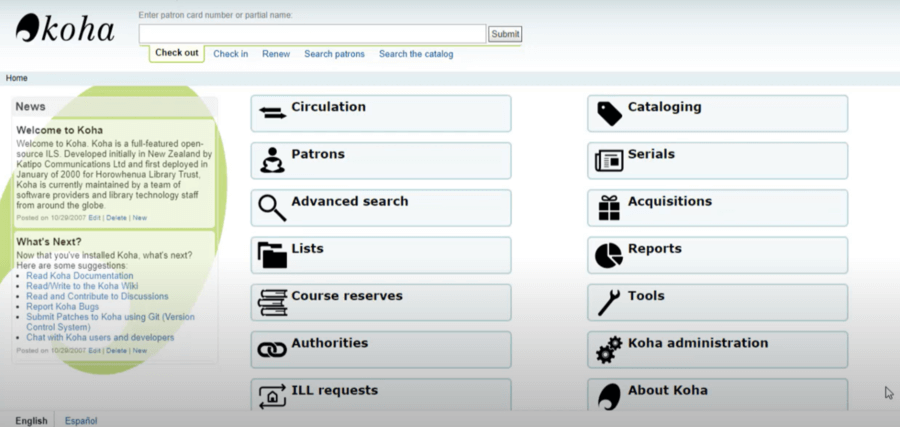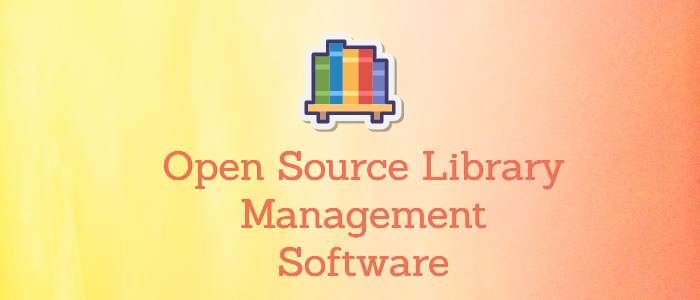Library management software is a tool to manage the in-house functioning of a library. It helps to manage, handle, and maintain countless books in the library.
Library management software allows you to find books quickly, issue and reissue them instantly, and efficiently manage all the data.
In this article, we will give you a brief on the best open source library management software in 2023.
Library management system key advantages:
- Helps maintain accurate and comprehensive records
- Saves time and reduces manual work
- Easy search, add, update, issuing & returning of library materials
- Reduce library operating costs
- Automate book reservation, overdue notifications, book indexing etc.
Best Open Source Library Management Software
Here we will explain the best open source library management software available today in 2022.
1. Koha

Koha is an open-source feature-rich and scalable library management system. Koha was created in 1999 by Katipo Communications in New Zealand. According to the official website of Koha, they are the first free library management software available. Kohan development is sponsored by many libraries, volunteers, and support companies.
It is one of the best library management software used by schools, colleges, universities, and individuals in-home libraries. The easiest way to install Koha is on Debian-based operating systems, including Ubuntu and Mint. Koha recommended backend databases are MariaDB or MySQL.
Key Features of Koha
- Full-featured ILS - have basic and advanced options. Incudes modules for acquisitions, circulation, cataloging, serials management and more.
- Available in many langauges.
- Enhanced catalogue and powerful search option.
- Built using library standard and protocols such as MARC 21, UNIMARC, z39.50, SRU/SW, SIP2, SIP/NCIP.
- Web based interface - using XHTML, CSS and Javascript.
- Free to install and use.
2. Evergreen
Evergreen is an open-source and highly scalable Library management system. It was developed by the Georgia Public Library system in 2006. GNU GPL version 2 license governs this open-source software. It is a fantastic software for managing library items, handling library information, and tracking the data for the circulated library items.
Almost 2000+ libraries use Evergreen software to manage their library-related data easily. It offers features that assist users with back-end workflow operations, as well as a public catalog interface.
Features of Evergreen
- Evergreen offers flexible, template-based, customizable receipt printing.
- A user-friendly and uncluttered interface makes a big difference in daily work.
- It provides a public access catalog online as well as multiple payment methods.
- Users can generate reports, and Evergreen allows users to customize statistical reports.
- The pre-reminders option can help library management to get the library items back at a specific time.
- Evergreen provides an efficient cataloging service.
- It provides an RSS feed option for record generation and updates.
3. BiblioTEQ
BiblioTEQ is an open-source library management software that utilizes a QT interface to deliver excellent connectivity to SQLite and PostgreSQL. BiblioTEQ offers a professional library management system with the compatibility of a cataloging system. This tool can help users to manage journals, magazines, DVDs, CDs, books, and so forth.
BiblioTEQ also uses SRU and Z39.50 protocols for recovering information regarding books, journals, and magazines. It is available for most operating systems and compatible with any system that has QT support.
Features of BiblioTEQ
- BiblioTEQ has a customized display option and Alpha architecture support.
- It has embedded hyperlinks for the localized search of any item.
- It is compatible with OpenBSD, Mac, FreeBSD, Linux, OS/2, Windows.
- BiblioTEQ offers ARM architecture, Sparc64, PowerPC, and print support.
- It also allows uniform functionality on multiple platforms.
- BiblioTEQ provides an intuitive and appealing graphical user interface.
- BiblioTEQ supports multiple languages such as Arabic, Greek, French, German, Hungarian, English, Czech, Dutch, and Russian.
- It offers a wide range of search features, including custom SQL queries.
4. OPALS
OPALS is an open-source library management software that helps users to manage and handle huge libraries easily. According to the official website of OPALS, they manage two thousand plus libraries around the globe.
OPALS is a fully featured library automation system that enables libraries to function quickly and maintain library resources daily.
OPALs has a large community of public, education, special, and academic librarians. As part of the development of this excellent open-source library management software, these librarians collaborate with experienced software developers, system administrators, automation experts, and support technicians.
Features of OPALS
- OPALS has various options for cataloging library materials.
- It has the feature of importing, exporting, and merging items easily.
- Users can easily add, edit and remove fields anytime.
- It has real-time project options because it is an open-source platform.
- OPALS has a feature of statistical and dynamic report generation.
- Users can access calendars and digital archives.
- OPALS provides fantastic customer support services
- It is a cooperatively developed tool for managing libraries.
- It is an easy-to-use tool.
5. Invenio
Invenio is a library management tool based on the Invenio framework that already manages different open source tools. It is one of the best, scalable, safe, open-source, and free library management tools available.
Invenio is designed for handling a huge range of records because it has modern architecture. It is completely secured in terms of handling books related information and other essential data.
The multidisciplinary community of institutions designs this software. The entire platform enables the management of research data, institutional repositories, and assets.
Feature of Invenio
- Invenio provides one of the most flexible data models.
- It can handle several types of records.
- It offers a powerful search engine with amazing Elasticsearch technology.
- It provides features for file organization with the quota management system.
- Invenio can manage both bulk indexing and instant indexing.
- Invenio is extremely quick, robust, and reliable.
- It has a fantastic API collaboration.
- It also has a file management system to manage a vast number of files quickly.
6. SLiMS
SLiMS (SENAYAN Library Management System) is a free and open-source library management software that is built on jQuery, MySQL, PHP, etc. It offers multiple features like circulation, membership management, bibliography database, and interoperability layers through OAI-PMH. SENAYAN Library management software is GNU GPL licensed.
The prime focus of SLiMS is providing simplicity, ease of usage, and entire modules to automate the library tasks like cataloging, circulation, and so on.
Features of SLiMS
- SLiMS has OPAC with thumbnail document image compatibility.
- Mods (Metadata Object Description Schema) XML format records document detail in SLiMS
- It offers serial publication control
- It has barcode support for document items.
- It provides master files management to manage different data such as Publishers, Authors, Collection Types, GMD, Locations, etc.
7. Greenstone
Greenstone offers a complete package to store and share the digital library data without having any issues. Greenstone is an open-source library management software issued under GNU General Public License to create and distribute digital library information. Users can export the information on the web or a CD-ROM as it provides new and efficient organizing and publishing information.
Greenstone software is designed to empower universities, libraries, and other public service organizations, to build their online libraries.
Features of Greenstone
- Greenstone provides a user-friendly interface
- It provides an amazing interoperability
- It supports different metadata formats and document formats
- Users can create and distribute different data collections as per their needs.
- Users can also customize the interface according to the metadata.
- Greenstone has multi-platform support.
- It is easy to maintain this tool.
- It is flexible, customizable, and has multilingual support.
8. FOLIO
The full form of FOLIO is "Future of Libraries is Open," and it is considered as one of the most innovative library management software. Various library management teams, developers, and vendors have contributed to the development of this open-source library services platform.
FOLIO is a platform for controlling print and electronic library resources that is open-source. This solution includes functionality for managing libraries, is based on a modern architecture that allows continual innovation, and can integrate applications from third-party providers.
Features of FOLIO
- FOLIO provides powerful and flexible options to manage data.
- It has a user-friendly interface.
- It offers options to manage and search for specific information easily.
- It can handle several types of records.
- Users can export the records in different formats.
- It offers different features and creates multiple records of various library items.
Conclusion
Here we learned about some of the best available open-source library management software.
Please share your experience using it and suggestions in the comment section.




Comments